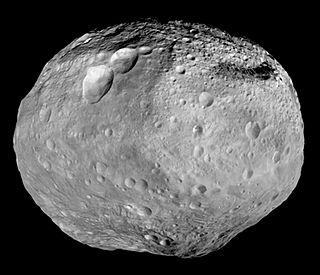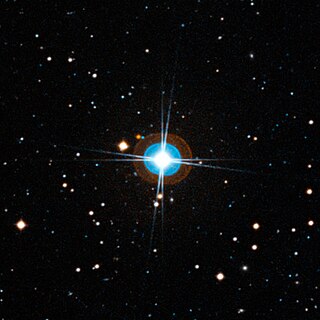
A protoplanet is a large planetary embryo that originated within a protoplanetary disc and has undergone internal melting to produce a differentiated interior. Protoplanets are thought to form out of kilometer-sized planetesimals that gravitationally perturb each other's orbits and collide, gradually coalescing into the dominant planets.

Chthonian planets are a hypothetical class of celestial objects resulting from the stripping away of a gas giant's hydrogen and helium atmosphere and outer layers, which is called hydrodynamic escape. Such atmospheric stripping is a likely result of proximity to a star. The remaining rocky or metallic core would resemble a terrestrial planet in many respects.
Mu Arae c, also known as HD 160691 c, formally named Dulcinea, is an extrasolar planet orbiting the star Mu Arae of the constellation Ara. It was the first 'hot Neptune' or 'mega-Earth' to be discovered.

A super-Earth is a type of exoplanet with a mass higher than Earth's, but substantially below those of the Solar System's ice giants, Uranus and Neptune, which are 14.5 and 17 times Earth's, respectively. The term "super-Earth" refers only to the mass of the planet, and so does not imply anything about the surface conditions or habitability. The alternative term "gas dwarfs" may be more accurate for those at the higher end of the mass scale, although "mini-Neptunes" is a more common term.

HD 164922 is a seventh magnitude G-type main sequence star in the constellation of Hercules. To view it, binoculars or a telescope are necessary, as it is too faint to be visible to the naked eye. It is 71.7 light-years distant from the Earth. It will soon evolve away from the main-sequence and expand to become a red giant.
This page describes exoplanet orbital and physical parameters.
HD 40307 c is an extrasolar planet orbiting the star HD 40307, located 42 light-years away in the direction of the southern constellation Pictor. The planet was discovered by the radial velocity method, using the HARPS apparatus, in June 2008. Of the six proposed planets in the HD 40307 star system, it is the third-largest, and has the second-closest orbit from the star. The planet is of interest as this star has relatively low metallicity, supporting a hypothesis that different metallicities in protostars determine what kind of planets they will form.
HD 204313 is a star with two and possibly three exoplanetary companions in the southern constellation of Capricornus. With an apparent magnitude of 7.99, it is an eighth magnitude star that is too faint to be readily visible to the naked eye. The star is located at a distance of 157 light years from the Sun based on parallax measurements, but it is drifting closer with a radial velocity of −10 km/s.

HD 10180, also designated 2MASS J01375356-6030414, is a Sun-like star in the southern constellation Hydrus that is notable for its large planetary system. Since its discovery, at least six exoplanets have been observed orbiting it, and some studies have proposed up to nine potential planets, which would make it potentially the largest of all known planetary systems, including the Solar System.

An exoplanet is a planet located outside the Solar System. The first evidence of an exoplanet was noted as early as 1917, but was not recognized as such until 2016; no planet discovery has yet come from that evidence. What turned out to be the first detection of an exoplanet was published among a list of possible candidates in 1988, though not confirmed until 2003. The first confirmed detection came in 1992, with the discovery of terrestrial-mass planets orbiting the pulsar PSR B1257+12. The first confirmation of an exoplanet orbiting a main-sequence star was made in 1995, when a giant planet was found in a four-day orbit around the nearby star 51 Pegasi. Some exoplanets have been imaged directly by telescopes, but the vast majority have been detected through indirect methods, such as the transit method and the radial-velocity method. As of 1 May 2023, there are 5,366 confirmed exoplanets in 3,962 planetary systems, with 856 systems having more than one planet. This is a list of the most notable discoveries.
HD 192310 c is an exoplanet orbiting the star HD 192310 which is about 29 light years away in the far south-west of Capricornus. It is a Neptune-sized planet and was discovered on 17 August 2011 by the HARPS program.
HD 20781 is a star which is part of a wide binary system with HD 20782. The companion star has a very large angular separation of 252 arcsec, corresponding to 9080 AU at the distance of HD 20782. Both stars possess their own planetary systems in S type orbits, with a total of five known planets around both stars. This is the first known example of planets being found orbiting both components of a wide binary system. HD 20781 has no noticeable starspot activity.
HD 109271 is a star in the constellation of Virgo. With an apparent magnitude of 8.05, it cannot be seen with the naked eye. Parallax measurements made by Gaia put the star at a distance of 182 light-years away.

Kepler-90, also designated 2MASS J18574403+4918185, is an F-type star located about 2,790 light-years (855 pc) from Earth in the constellation of Draco. It is notable for possessing a planetary system that has the same number of observed planets as the Solar System.

HD 106906 b is a directly imaged planetary-mass companion and candidate exoplanet orbiting the star HD 106906, in the constellation Crux at about 336 ± 13 light-years (103 ± 4 pc) from Earth. It is estimated to be about eleven times the mass of Jupiter and is located about 738 AU away from its host star. HD 106906 b is rare in astronomy; while its mass estimate is nominally consistent with identifying it as an exoplanet, it appears at a much wider separation from its parent star than thought possible for in-situ formation from a protoplanetary disk.
HD 219134 g, also known as HR 8832 g, is an unconfirmed exoplanet orbiting around the K-type star HD 219134 in the constellation of Cassiopeia. It has a minimum mass of 11 or 15 Earth masses, suggesting that it is likely a Neptune-like ice giant. Unlike HD 219134 b and HD 219134 c it is not observed to transit and thus its radius and density are unknown. If it has an Earth-like composition, it would have a radius 1.9 times that of Earth. However, since it is probably a Neptune-like planet, it is likely larger.
Kepler-277b is the second most massive and third-largest rocky planet ever discovered, with a mass close to that of Saturn. Discovered in 2014 by the Kepler Space Telescope, Kepler-277b is a sub-Neptune sized exoplanet with a very high mass and density for an object of its radius, suggesting a composition made mainly of rock and iron. Along with its sister planet, Kepler-277c, the planet's mass was determined using transit-timing variations (TTVs).
HD 21693 is a star in the constellation Reticulum. It has an apparent visual magnitude of 7.94, therefore it is not visible to the naked eye. From its parallax measured by the Gaia spacecraft, it is located at a distance of 108.6 light-years (33.3 parsecs) from Earth.








